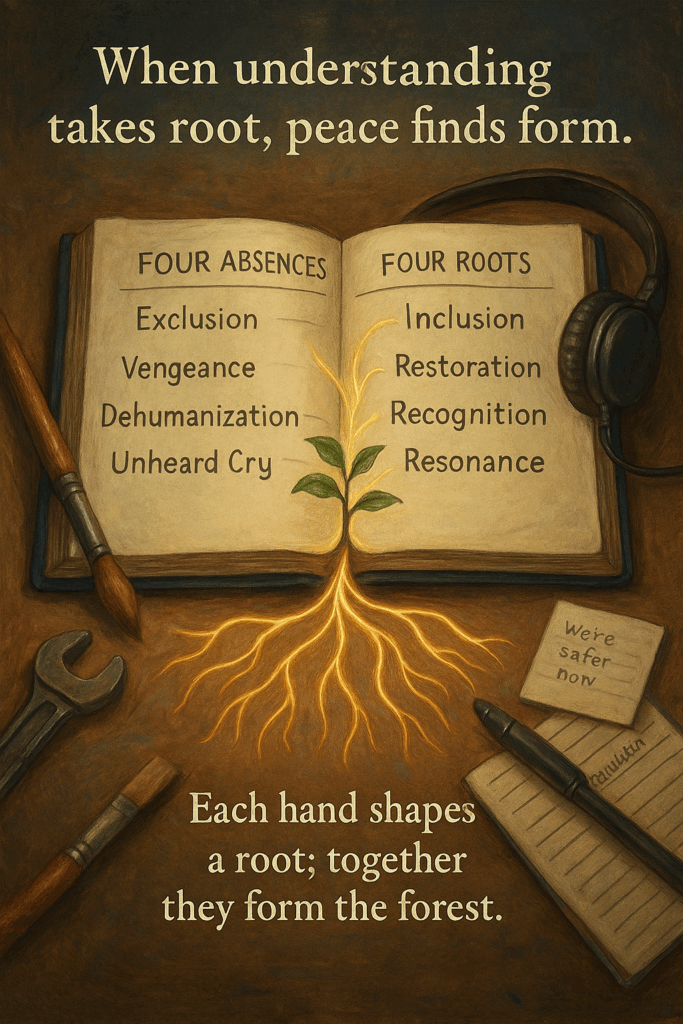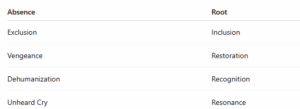
The greenhouse welcomed them back on January 15, 2026, its patched glass cleared of frost, revealing a pale winter sun that cast long shadows across the scarred table. The Circle of Seeds reconvened after a short break—time spent with families, reflecting on the UN presentation and the funding storm’s resolution. The seedling tray now held stronger basil and beans, their roots visible through the soil, a testament to quiet growth. The ledger lay open, its pages filled with notes from East Riverton and whispers of Kyiv’s horizon. Jaden was mending the canopy’s steel frame, sparks flashing briefly in the dim light. Priya sorted printouts on the table—charts of empathy metrics, drafts of the feasibility report, and a page labeled Comprehension Protocol (Draft 1).
Mina sat cross-legged by the window, transcribing quiet-box entries into the Human Voices archive. Aisha leaned over the mural sketch, tracing new branches across a cracked rooftop. The word KYIV was written faintly in the corner, almost like a whisper.
The door opened, and Emil stepped in, a thin layer of snow melting from his coat. His face carried the calm of someone who had seen a storm and understood its rhythm.
“Morning, Circle,” he said.
Aisha looked up. “You were with Grandfather again?”
He nodded. “Yes. We mapped the Korean conflict—applied the Four Absences step by step. It changed how I see things. It’s not about solving everything—it’s about preparing the conditions where healing can begin. Peace is soil, not seed.”
Priya raised an eyebrow. “So how do we translate that into our work? We’re gardeners, not diplomats.”
“Exactly,” Emil said, pulling out the ledger. “We’re not building treaties. We’re building understanding. That’s what this framework is for.”
He opened the ledger to a new page labeled Four Absences to Four Roots.
On the board, he drew two columns—Absences on one side, Roots on the other:

“These,” Emil said, “are not just categories—they’re signals. When we log an incident or a voice in the ledger, we’ll tag it with one of these four pairs. Each tells us what’s missing—and what we can grow in its place.”
Mina leaned forward. “So if someone writes, ‘I just want to walk home safe,’ that’s Absence Four?”
“Exactly,” Emil said. “It’s the Unheard Cry—a distortion of the instinct for safety and love. Its root is Resonance—the ability to feel heard and connected. So in Kyiv, if we see silence, we don’t just record it. We design for resonance—safe spaces, story circles, shared walls.”
Jaden grinned. “Like structural gardening.”
Aisha laughed. “Trust him to make architecture poetic.”
Priya scrolled through her laptop. “We can integrate this into our feasibility report. Replace conflict-reduction percentages with Restoration Indicators—how many shared voices, how many reconciled spaces.”
Emil nodded. “Exactly. And we’ll use the Comprehension Protocol to guide it—tracing how each Absence leads to another. If Exclusion grows, Vengeance follows. If Vengeance festers, Humanity erodes. The cycle continues unless someone tends the roots.”
He looked around the room. “That’s our real task—not to stop fights, but to break the cycle.”
Olena, the Ukrainian-American keeper, entered quietly, brushing snow from her sleeves. “The council’s reviewing your report next week,” she said. “Hargrove still doubts this will hold in a war zone.”
Emil smiled. “Then we’ll show him a framework that grows even in rubble.”
Olena continued, “My cousin in Kyiv says the shelters are full,” she said, her voice steady but edged with worry. “They need more than boxes—they need to be seen.”
Emil nodded, opening the ledger to the Applying the Absences entry. “Grandfather showed me how the absences chain together—like in Korea. Wisdom lost feeds values abandoned, values erode humanity, humanity twists instincts. We’ll use that for Kyiv, to diagnose and heal at scale.”
Evening Reflection
By dusk, the Circle’s worktable was covered with notes, seed trays, and half-finished sketches. The heater’s hum blended with the soft scratching of pens. Aisha’s mural draft now showed two trees growing from one cracked wall, their roots intertwined beneath. Priya had rewritten the feasibility summary: Peace is measured not in silence, but in restored voice.
Mina held up a quiet-box slip. “This one’s new,” she said softly. “A kid from East Riverton wrote, ‘I told my brother sorry.’ That’s small—but it’s resonance.”
Emil smiled. “That’s the beginning of a cycle reversed.”
Jaden added a final bolt to the canopy frame. “The metal holds,” he said, “even in cold.”
As the night deepened, snow tapped gently on the glass. The Circle gathered around the table. Emil drew the lamp closer, its light spilling across the ledger.
Ledger Entry — The Winter Ledger
Date: January 22, 2026
Symptom: Post-holiday recalibration; need to operationalize the Four Absences Framework for Kyiv and future pilots.
Disease — The Four Absences (Local to Global):
-
Absence 1 (Exclusion): Reports isolated by data metrics; empathy not standardized.
-
Absence 2 (Vengeance): Bureaucratic pushback framed as “accountability”; reactive policy.
-
Absence 3 (Dehumanization): Youth-led methods labeled “soft” or “non-strategic.”
-
Absence 4 (Unheard Cry): Marginal voices risk being filtered out of feasibility frameworks.
Investigator’s Response:
-
Defined the Four Roots Model (Inclusion, Restoration, Recognition, Resonance).
-
Updated Feasibility Report: empathy metrics replace reduction percentages.
-
Created Comprehension Protocol 1.0 linking Absence–Root pathways.
-
Established Dignity Indicators: 1) restored dialogue, 2) safe shared spaces, 3) co-created art.
-
Integrated Olena’s cultural context briefing for Kyiv.
Outcome:
Kyiv readiness model complete; report submitted for review; framework adaptable for global peace pilots.
Note:
Every winter has a ledger—the record of what roots survived the frost. Growth is not spring’s gift, but winter’s endurance.

